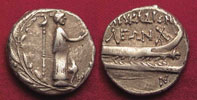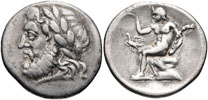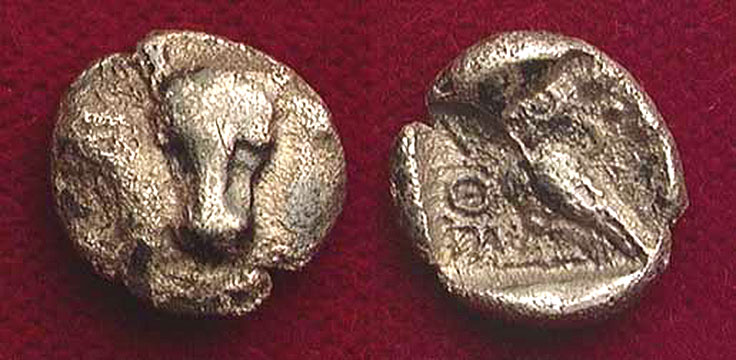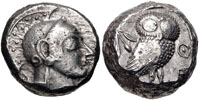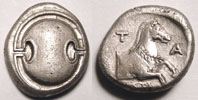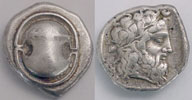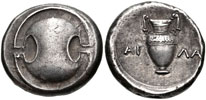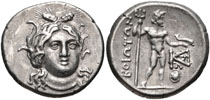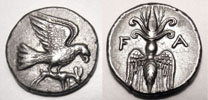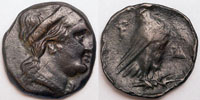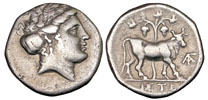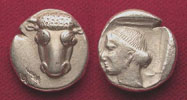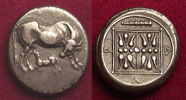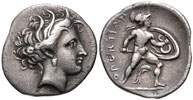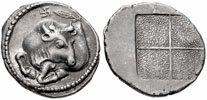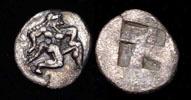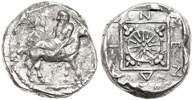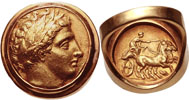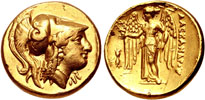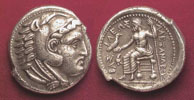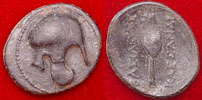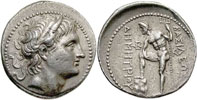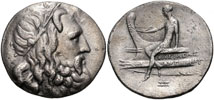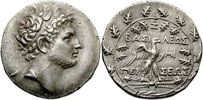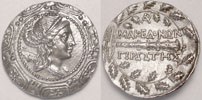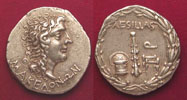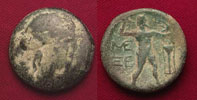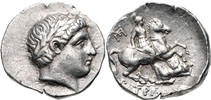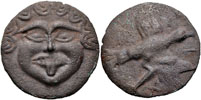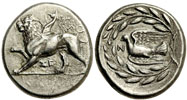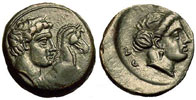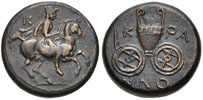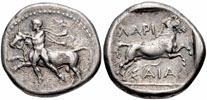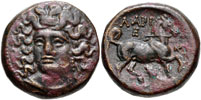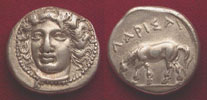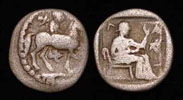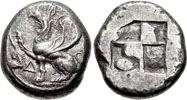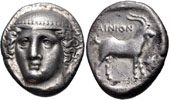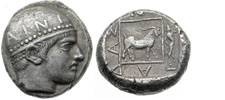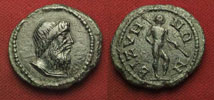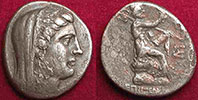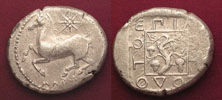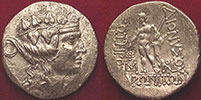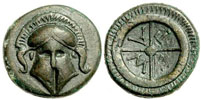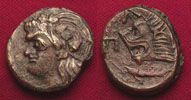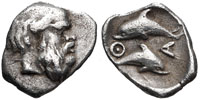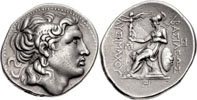(Greece & Thrace)
Collection L - Reasonable Offers Welcome
AIGINA AKARNANIA ARGOLIS ARKADIA ATTICA BOEOTIA BOSPORUS CORINTHIA CRETE ELIS EUBOIA ILLYRIA LOKRIS MACEDON KINGS MEGARIS MESSENIA MOESIA PAEONIA SCYTHIA SIKYONIA THESSALY THRACE WEIGHTS MAP
AIGINA
AKARNANIA
6059. AKARNANIA, ANACTORIUM, c. 300-250BC. AR Stater, Copenhagen 299v. Pegasos flying l., AN monogram beneath/Hd. Athena l., bucranium to r. EF.
ARGOLIS
ARKADIA
ATTICA (map)
BOEOTIA
BOSPORUS
CORINTHIA
CRETE
ELIS
EUBOIA
8547. EUBOIA, PHOKIS, ca. 460 BC. AR Triobol, Sear 2347v. Bucranium (bull's head) facing/Head of Artemis l. in incuse square. EF/VF. Exceptional sharp high-profile bull head.
ILLYRIA
LOKRIS
MACEDON
7707. MACEDON, LETE, 500-480 BC. Trihemiobol, Sear 1302. Naked Ithyphallic satyr running r./Quadripartite incuse. EF.
MACEDONIAN KINGS
10338. MACEDON, KINGS, KASSANDER, 316-297 BC. AE Unit - 19mm. Helmet with cheek guards / BASILEWS left, KASSANDROU right; spear head. SNG Copenhagen 1163; Laffaille 315; SNG Tübingen 1171. VF
13026. MACEDONIAN QUEEN CONSORT, EURYDIKE WIFE OF ANTIPATER II, 306-283 BC. IONIA, Smyrna (as Eurydikeia). Circa 290-287/1 BC. Æ (17mm, 3.84 g, 6h). Veiled head of Eurydike right / ΕΥΡΥΔΙΚΕΩΝ, tripod. Milne, Autonomous 5; SNG Copenhagen 1105. VF, dark green patina with earthen highlights/deposits. Rare. Good VF. An excellent example of this rare coin portraying the Macedonian princess Eurydike (not to be confused with a number of other Eurydikes of Macedon, Egypt,The Seleucid empire, or from Greek Mythology.) At an unknown date, Lysimachus renamed the city Smyrna to Eurydiceia in honor of Eurydice, though the change didn't last long. Lysimachus issued coinage depicting Eurydice on the obverse as a veiled woman, although Eurydice never owned nor had any control of the city. Little is known of her life prior to marrying. See here for a biography.
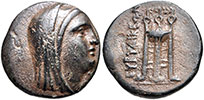
MEGARIS (map)
10582. MEGARIS, MEGARA, 1st-2nd century BC. AE15, 4.58 gm. Kroll-Walker 218. Laureate head of Apollo right. Reverse: Tripod. VF. Ex BCD collection.
MESSENIA
MOESIA
PAEONIA
9413. PAEONIA, LYKKEIOS, 359-340BC. Tetradrachm, S1518. Hd Zeus r./Herakles fighting Nemean lion. EF. $2250.
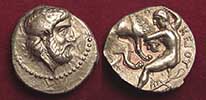
SCYTHIA
SIKYONIA
THESSALY
9397. THESSALY, TRIKKA, 440-400 BC. AR Obol, Copenhagen, 114/15. Horse prancing r. Reverse: TPIKKAI right down & ON left up; nymph bouncing a ball. VF. Rare. A charming type! SOLD.
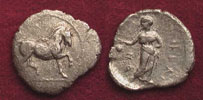
THRACE
9399. THRACE, AINOS, c. 435-405. AR diobol, S1567. Hd Hermes r/AIN, male goat standing right, club before. Nicely styled goat before. Toned EF. Rare! Better than image. 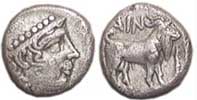
9390. THRACE, OLBIA, IV-III cc. BC. AE. Borysthenes head left / double axe, bow in a bow case, OLBIO. 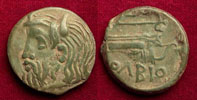
9351. THRACE, PANTIKAPION, 4th century BC. AE17, Sear_. Bearded head of Pan l./Bull head l. AEF. An excellent example. Arguably the best depiction of Pan in bronze. 
11195. THRACO-MACEDONIAN REGION, SIRIS. AR 1/8 Stater - Trihemiobol, Circa 412-404 BC. AR Diobol. Satyr squatting right. / Quadripartite incuse. 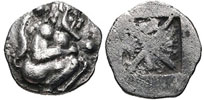
9389. THRACE, THASOS, 411-350 BC. AR Drachm, Copenhagen 1023. Hd. Dionysos l./Herakles drawing bow r. within square. EF. Rare. SOLD.
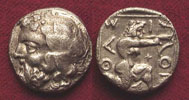
WEIGHTS



